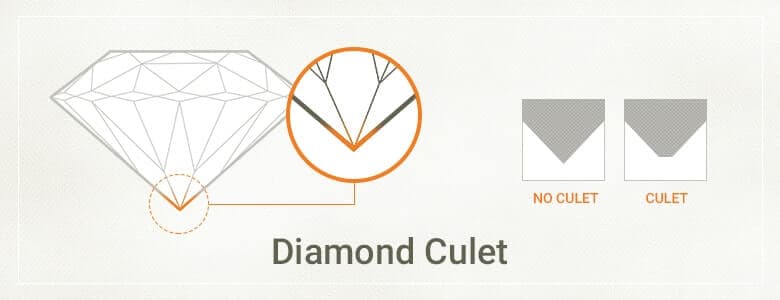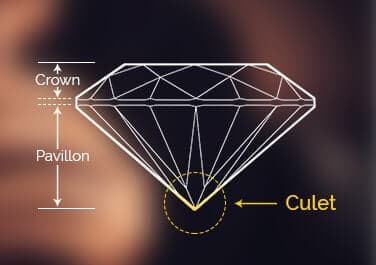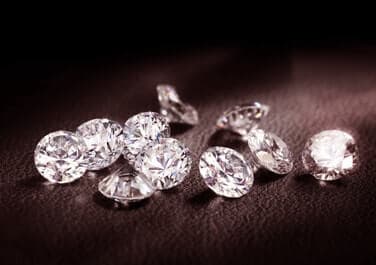Free Insured Shipping Nationwide | 1500+ latest designs
Available on Amazon India
Diamond Education
Gemstone Education
Metal Education
Jewellry Guide
Pearl Education
More Guide
Policies
Diamond Culet (Pronunciation kyoo-lit)
The tiny point at the base of the pavilion where the facets of the pavilion meet is called a culet of a diamond. In most of the diamonds these pavilion facets are cut uniformly, at appropriate angle and they meet at a perfect point, yielding no culet (known as pointed culet). A culet is a rough or a polished facet when the pavilion facets do not meet at point. A diamonds total number of facets increase due to the presence of a culet while a pointed culet does not. For instance, a round diamond having faceted culet has 60 facets whilst a precious stone having a pointed culet has 57 facets.

Rating a diamond culet
A diamond culet rating ranges from none to extremely large. During the time when a loose diamond is being certified it is viewed having its face up to decide the size of the culet and to determine the angle of a culet it is viewed from the side. A culet is determined as an extra facet when it is sharply angled i.e. it is no longer assessed as a culet.
A size of the culet can also be determined as a percentage relative to the diameter of the diamond, approximately ranging from 1.5% to 15%. This statement holds true for diamonds with culet that range from small to extremely large.

Culet's effect:
They were used very commonly in old European cut and old miner's cut diamonds almost a hundred years ago. Culets that are large in size are not popular among the state of the art cutting standards because when viewed from above they are visible through the table facet. A culet whose size ranges from large to extremely large behaves like a window that is parallel to the table of the diamond which allows the light to run away through the bottom side due to which the culet appears as a dark circle.

A small or a medium sized culet will have a point at the bottom side of the pavilion, which will perfectly reflect the light passing through the stone. There is a risk of the pointed culet being chipped while setting or being worn, hence it is important to cover the diamonds in a protective manner to reduce the contact with robust and rough surfaces. If the setting is kept high then it will also refrain from contacting with the metal or the finger. Some cutters deliberately cut a small culet to reduce the risk of chipping. It is recommended to choose a diamond with a culet that ranges from small to none since this since it will display better brilliance and fire.
































































